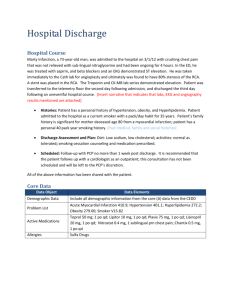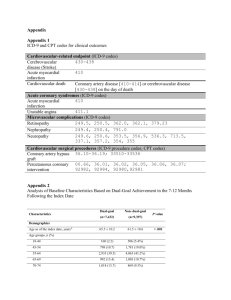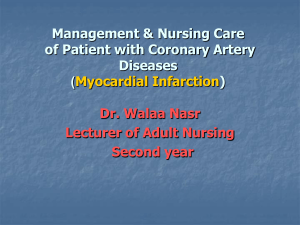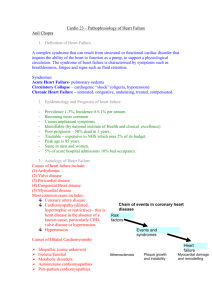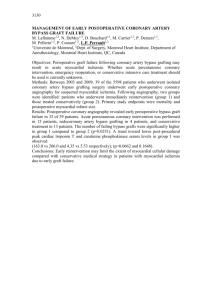Premature Myocardial Infarction
advertisement
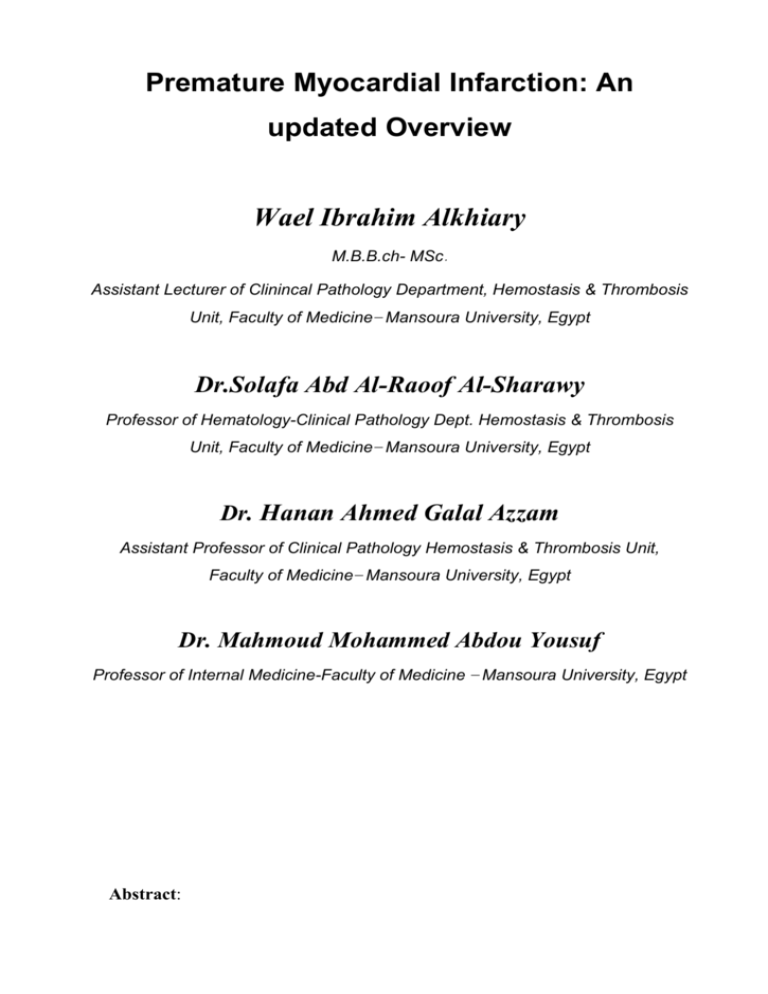
Premature Myocardial Infarction: An updated Overview Wael Ibrahim Alkhiary M.B.B.ch- MSc. Assistant Lecturer of Clinincal Pathology Department, Hemostasis & Thrombosis Unit, Faculty of Medicine– Mansoura University, Egypt Dr.Solafa Abd Al-Raoof Al-Sharawy Professor of Hematology-Clinical Pathology Dept. Hemostasis & Thrombosis Unit, Faculty of Medicine– Mansoura University, Egypt Dr. Hanan Ahmed Galal Azzam Assistant Professor of Clinical Pathology Hemostasis & Thrombosis Unit, Faculty of Medicine– Mansoura University, Egypt Dr. Mahmoud Mohammed Abdou Yousuf Professor of Internal Medicine-Faculty of Medicine – Mansoura University, Egypt Abstract: Although myocardial infarction (AMI) is usually the disease of older people over 45 years of age, an increasing number of younger patients is being recorded. Additionally, AMI in very young patients aged 35 years and younger has been poorly described. Besides atherosclerotic coronary artery disease, nonatherosclerotic coronary artery diseases or hypercoagulability should be considered for young cases of myocardial infarction. The predominance of angiographic single-vessel disease and myocardial infarction with normal coronary arteries in these patients primarily suggest that premature myocardial infarction probably result from a rapid progressive event, such as thrombosis or plaque rupture, rather than a gradually evolving process, such as atherosclerosis. In the future, atherosclerotic burden, hemostatic function, characterization of stressors and inflammation will be important targets for research in this group of patients. Advancing age is a well-acknowledged risk factor for AMI in both men and women. Although myocardial infarction (MI) is usually the disease of older people over 45 years of age, an increasing number of younger patients is being recorded presenting with premature myocardial infarction (1). It is estimated that about less than 10% of individuals presenting with documented CAD are <45 years of age (2). However, this estimate could vary considerably depending on the population at study. The increased prevalence in young adults can be partly attributed to the increased prevalence of risk factors for atherosclerosis among the population under the age of 40 (3). Besides atherosclerotic coronary artery disease, non-atherosclerotic coronary artery diseases or hypercoagulability should be considered for young cases of myocardial infarction (4,5). Although CHD is an uncommon entity in young patients, it constitutes an important problem for both the patient and the physician because of the devastating effect of this disease. More importantly, these patients have different risk factor profiles, clinical presentations, and prognoses than older patients. Myocardial infarction presenting at a young age shows a different clinical, angiographic findings and pathophysiological profile compared to older (2, 6-11). Additionally, MI in very young patients (aged 35 years and younger) has been poorly described (12). Traditional risk factors of CAD seen in the elderly age group do not apply to younger age group (13-15). Young patients tend to have less extensive atheromatous lesions and the contribution of prothrombotic and inflammatory indices may be particularly implicated in the initiation and development of such atherosclerotic lesions (8,9). It is also known that the long-term prognosis and functional status of young patients who have acute myocardial infarction (MI) is not benign (2,6,16). Myocardial Infarction with Normal Coronary Arteries (MINCA) is an important subgroup of myocardial infarction in young patients with a frequency of at least 3-4% of all myocardial infarctions. The proposed mechanisms for MINCA include coronary vasospasm, coronary thrombosis in situ or embolization from a distal source with spontaneous lysis, cocaine abuse, viral myocarditis, aortic dissection, hypercoagulable states, autoimmune vasculitis and carbon monoxide poisoning (17). Moreover, the predominance of angiographic single-vessel disease in these young patients primarily suggest that premature myocardial infarction probably result from a rapid progressive event, such as thrombosis or plaque rupture, rather than a gradually evolving process, such as atherosclerosis, and thus substantiate the need for an intense and aggressive approach directed towards primary and secondary preventions of premature cardiovascular disease (11). It is unknown whether the incidence of MI at an early age incorporates a grave prognosis or warrants an approach that is different from that used in older patients (12). Nevertheless, it is unclear whether AMI at the younger age can be considered an autonomous representation of the infarct process or a more premature and accelerated expression of the same atherosclerotic process witnessed in older population. Attempts to study this aspect have been stalled by the relative infrequency of AMI in the young, as well as the inconsistencies regarding the definition of youth (10). Intravascular thrombogenesis is influenced by a complex interplay of procoagulant, anticoagulant, fibrinolytic, endothelial damage/dysfunction and inflammatory factors. Abnormalities of these biological systems would contribute to coronary artery disease presenting at a young age (9). Clinical features suggesting underlying arterial thrombophilia in Premature CAD include:1) Previous arterial thrombosis and age ≤ 50 (male) or ≤ 55 (female); 2) Age ≤ 55(male) or ≤ 60 (female) with no other traditional risk factors present; 3) No significant coronary stenosis on angiography; and 4) Age ≤ 55 (male) or ≤ 60 (female) with strong family history (defined as at least one first-degree relative affected at age 50 years if male or 55 years if female) (4,18). In the future, atherosclerotic burden, hemostatic function, characterization of stressors and inflammation will be important targets for research in this group of patients (17). References 1. Celik T, Iyisoy A (2010): Premature coronary artery disease in young patients:an uncommon but gro wing entity. Int J Cardiol.;144:131-2. 2. Schoenenberger AW, Radovanovic D, Stauffer JC, Windecker S, Urban P, Niedermaier G, Keller PF, Gutzwiller F, Erne P; AMIS Plus Investigators (2011): Acute coronary syndromes in young patients: presentation, treatment and outcome. Int J Cardiol.;148:300-4. 3. Chan MY, Woo KS, Chia BL, et al. (2006): Antecedent risk factors and their control in young patients with a first myocardial infarction. Singapore Med J.;47:27 –30. 4. Chan MY, Andreotti F, Becker RC (2008): Hypercoagulable States in Cardiovascular Disease. Circulation;118:2286-2297. 5. Cengel A, Tanindi A (2009): Myocardial infarction in the young. J Postgrad Med.; 55: 305-313. 6. Gotsman I, Lotan C, Mosseri M (2003): Clinical manifestations and outcome of acute myocardial infarction in very young patients. Isr Med Assoc J.;5:633-6. 7. Tewari S, Kumar S, Kapoor A, Singh U, Agarwal A, Bharti BB, Garg N, Goel PK, Sinha N (2005): Premature coronary artery disease in North India: an angiography study of 1971 patients. Indian Heart J.;57:311-8. 8. Pineda J, Marín F, Roldán V, Valencia J, Marco P, Sogorb F (2008): Premature myocardial infarction: clinical profile and angiographic findings. Int J Cardiol.;126:127–9. 9. Pineda J, Marín F, Marco P, Roldán V, Valencia J, Ruiz-Nodar JM, Sogorb F, Lip GY (2009): Premature coronary artery disease in young (age <45) subjects: interactions of lipid profile, thrombophilic and haemostatic markers. Int J Cardiol.;136:222-5. 10.Shah SS, Noor L, Shah SH, Shahsawar, Shahab Ud Din, Awan ZA, Hafizullah M (2010): Myocardial Infarction In Young Versus Older Adults : Clinical Characteristics And Angiographic Features. J Ayub Med Coll Abbottabad.;22:187-190. 11.Bajaj S, Shamoon VA, Hamdan F, Gupta N, Parikh A, Bikkina M R, Parikh (2011): N, Debari Acute ST- segment elevation myocardial infarction in young adults: who is at risk? Coron Artery Dis.; 22:238-44. 12.Christus T, Shukkur AM, Rashdan I, Koshy T, Alanbaei M, Zubaid M, Hayat N, AlsayeghA (2011): Coronary Artery Disease in Patients Aged 35 or Less – A Different Beast? Heart Views; 12:7-11. 13.Doughty M, Mehta R, Bruckman D, Das S, Karavite D, Tsai T, et al.(2002): Acute myocardi al infarction in the young– The University of Michigan experience. Am Heart J.;143:56-62. 14.Woon VC, Lim KH (2003): Acute myocardial infarction in the elderly – the differences compared with the young. Singapore Med J.; 44:414-8. 15.Cole JH, Miller JI, Sperling LS, Weintraub WS (2003): Long term follow up of coronary artery disease presenting in young adults. J Am Coll Cardiol.;41:521-8. 16.Fournier JA, Cabezon S, Cayuela A, et al. (2004): Long-term prognosis of patients having acute myocardial infarction when ≤ 40 years of age. Am J Cardiol.;94:989–92. 17. Agewall M, Jernberg S, Eurenius L, Hofman-Bang T, Tornvall P infarction with angiographically normal coronary C, Malmqvist K, Frick (2011): Myocardial arteries. Atherosclerosis; 219:10-4. 18. Andreotti F, Becker RC (2005): Atherothrombotic disorders: new insights from hematology. Circulation;111:1855–186.

